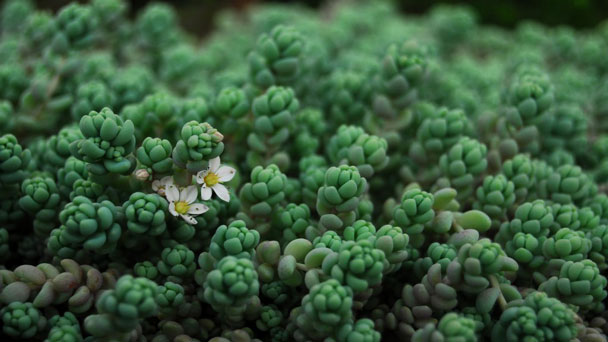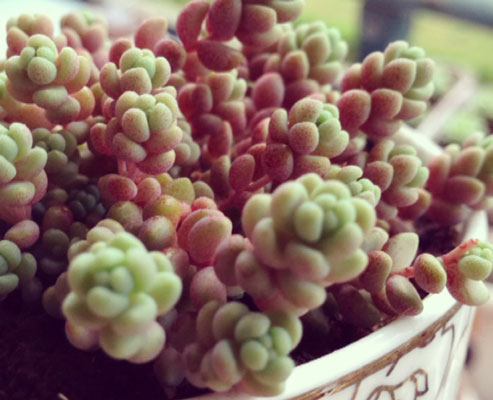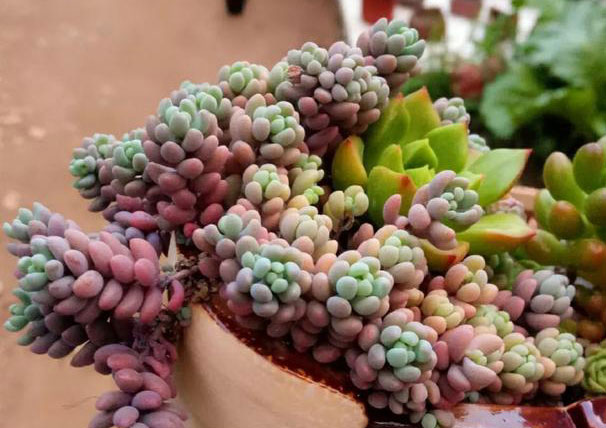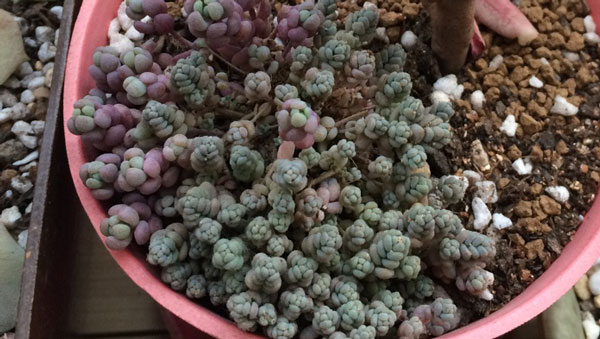Sedum Dasyphyllum (Corsican Stonecrop) Care & Porpagation Guide
Written by Iris
Oct 13 2021

In summer, Sedum dasyphyllum (Corsican Stonecrop) is dormant, but the dormant period is very short. Sedum Dasyphyllum growing season is spring and autumn. In winter, it can endure 3 degrees below zero. Winter temperature is too low growth will slow down, less water, the growing period of the sun can be full sunshine, the sun is strong, the plant will become short, creeping on the ground, the color will be very charming pink, very lovely. If the light is short, shading time is long, it is easy to grow tall, the leaves are not compact enough, empty long obvious, easy to fall, not beautiful. Below are details on how to care for Sedum Dasyphyllum.
Plant in an area of your garden that gets 6 hours of sunlight a day. If planting indoors, place in a room that gets a lot of sunlight, such as near a southern-facing window (if you're in the Northern Hemisphere).
Sedum Dasyphyllum is not cold, hardy, and does not do well in low-temperature places. If you live in an area that experiences extreme winters, make sure that you only grow Sedum Dasyphyllum indoors. Freezing temperatures can kill your plant, so make sure that you are growing Sedum Dasyphyllum in a room that is temperature controlled to be warm. You can also get a mini-greenhouse for your succulents if you feel that they may not survive the winters.
As a general rule of thumb, DO NOT water your Sedum Dasyphyllum until the soil has completely dried out from top to bottom of the pot. You can check by simply inserting a finger in the soil of your plant to feel if it’s still wet or dry.
If your Sedum Dasyphyllum has drawn the attention of snails and slugs, you can manually remove them from the plant. Using DIY remedies, such as soapy water spray or neem oil, will also help keep any pests away from your succulent.
If you live in a humid climate or your plant receives too much water, it might be susceptible to mold and rot. While mold can be removed once your plant has started rotting, there is nothing you can do about it. You may be able to salvage healthier stems and use them for propagation.
Where to Grow Sedum DasyphyllumHow to Grow Sedum dasyphyllum (Corsican Stonecrop)Sedum Dasyphyllum Propagation with Stem CuttingsSedum Dasyphyllum Propagation with DivisionHow to Care for Sedum dasyphyllum (Corsican Stonecrop)Sedum Dasyphyllum Light RequirementsSedum Dasyphyllum Soil CareSedum Dasyphyllum WateringSedum Dasyphyllum Temperature & HumiditySedum Dasyphyllum FertilizerSedum Dasyphyllum Pests & Diseases
Where to Grow Sedum Dasyphyllum
Sedum Dasyphyllum (Corsican Stonecrop) is not cold hardy, although it is frost tolerant. If you live in a zone that gets colder than 0° F (32° C), it's best to plant this succulent in a container that can be brought indoors. It does well in full to partial sun.Plant in an area of your garden that gets 6 hours of sunlight a day. If planting indoors, place in a room that gets a lot of sunlight, such as near a southern-facing window (if you're in the Northern Hemisphere).
How to Grow Sedum dasyphyllum (Corsican Stonecrop)
Sedum Dasyphyllum Propagation with Stem Cuttings
Propagating sedum dasyphyllum (Corsican Stonecrop) is easy. You may either wait for it to propagate on its own or do it yourself. Plus, the process is simple! If their stems grow too long, you can snip 3 to 4-inches of at least 3 or more cuttings from the mother plant by using a clean, sharp knife or scissors and make sure to allow your cuttings to callous over for about 2-3 days before placing them on a well-draining potting mix. And remember to water them after 2-3 days or whenever you feel that the soil is completely dry.Sedum Dasyphyllum Propagation with Division
Unlike any other succulents, you can have your own garden full of Sedum dasyphyllum without even buying a new one.- Get a portion of your Sedum Dasyphyllum by cutting a complete circle of it using a shovel or garden trowel. Remember to cut about 2-inches away from your Sedum Dasyphyllum and about 2 to 6-inches deep.
- Cut out small pieces of the Sedum Dasyphyllum. Don’t worry, the remaining ones can fill in the empty spaces quickly.
- Shake the excess soil from your Sedum Dasyphyllum roots until you can see the crown and its roots.
- Pull your Sedum Dasyphyllum apart into multiple portions using your hands. Do this from its natural division; including separate stems or carefully split sections in the root system.
- Plant your divisions in a fertile, well-drained soil under full sun. Make sure to dig as deep and twice wider as where they were originally planted.

How to Care for Sedum dasyphyllum (Corsican Stonecrop)
Sedum Dasyphyllum Light Requirements
Sedum Dasyphyllum needs 5 to 6 hours of sunlight to grow properly. It is a very hardy plant that will still grow even if you do not put in a lot of care. But the sun is essential for Sedum Dasyphyllum to thrive. It does well in full sun and can be grown in partial shade.If you are growing your Sedum Dasyphyllum indoors, make sure that you keep it in a well-lit room. The best place for Sedum Dasyphyllum is next to a window that lets in lots of sunlight.Sedum Dasyphyllum is not cold, hardy, and does not do well in low-temperature places. If you live in an area that experiences extreme winters, make sure that you only grow Sedum Dasyphyllum indoors. Freezing temperatures can kill your plant, so make sure that you are growing Sedum Dasyphyllum in a room that is temperature controlled to be warm. You can also get a mini-greenhouse for your succulents if you feel that they may not survive the winters.
Sedum Dasyphyllum Soil Care
Since Sedum Dasyphyllum are very susceptible to mold disease, rust, and rot when stayed in wet for too long, it is necessary to keep their foliage and soil dry. So make sure to plant them in porous, well-drained soil just like any other succulents. You may use a cactus or succulent soil and add some pumice, perlite, or grit added to create proper drainage for it.Sedum Dasyphyllum Watering
Although Sedum Dasyphyllum can withstand extended drought and still flourish on neglect, it still has watering needs to remain healthy. Remember to water the Sedum Dasyphyllum plant at least once every 10-14 days or whenever the soil is completely dry. Do this by pouring some water onto the soil until it is completely soaked.As a general rule of thumb, DO NOT water your Sedum Dasyphyllum until the soil has completely dried out from top to bottom of the pot. You can check by simply inserting a finger in the soil of your plant to feel if it’s still wet or dry.
Sedum Dasyphyllum Temperature & Humidity
It Prefers ideal temperature between 65°F – 75°F / 18°C – 25°C during summer. Temperature no lower than 50 °F – 55°F / 10°F – 12.7°C is best. It does best in hotter conditions. Try not to keep the plant outside in freezing temperatures.Sedum Dasyphyllum Fertilizer
Fertilize Sedum Dasyphyllum once a month with a diluted liquid fertilizer or use a slow-releasing nitrogen-based fertilizer, during the spring and summer season.Sedum Dasyphyllum Pests & Diseases
Sedum Dasyphyllum, like most succulents, remains susceptible to scale insects and mealybugs. If your plant has been infested, you can remove it by wiping the infested site with a Q-Tip dipped in rubbing alcohol.If your Sedum Dasyphyllum has drawn the attention of snails and slugs, you can manually remove them from the plant. Using DIY remedies, such as soapy water spray or neem oil, will also help keep any pests away from your succulent.
If you live in a humid climate or your plant receives too much water, it might be susceptible to mold and rot. While mold can be removed once your plant has started rotting, there is nothing you can do about it. You may be able to salvage healthier stems and use them for propagation.

Latest Updated
- Benefits of Bugleweed - 7 Science-backed Health Benefits
- Bugleweed Dangers & Side Effects - Is It Poisonous?
- How to Plant Evergreen Trees - What You Should Know
- When to Plant Evergreens - Grow Guide for Evergreen Trees
- 12 Wonderful Evergreen Shrubs for Your Garden
- 12 Popular Evergreen Plants with Pictures for Beginners
- When And How To Prune A Lilac Bush Like a Pro
- How to Grow & Care for Lilac Vine (Hardenbergia Violacea)
- Japanese Lilac Tree (Syringa Reticulata) Care & Propagation Guide
- Shumard Oak Pros and Cons - What to Know
Popular Articles
- Winter maintenance of Antirrhinum Majus
- How to Grow Terminalia Mantaly Tree
- How to Grow and Care for Crossostephium Chinense
- How to grow Antirrhinum Majus in spring
- Peristeria Elata (Dove Orchid) Profile: Info & Care Guide
- Underwatered Snake Plant (Sansevieria Trifasciata) - Signs And How To Fix
- How to Care for Brazilian Jasmine Plant (Mandevilla Sanderi)
- How to Grow & Care for Graptopetalum Purple Delight in Summer
- Rosa Chinensis (China Rose): Plant Growing & Care Tips
- How to Care for Baby Sun Rose (Aptenia Cordifolia)
